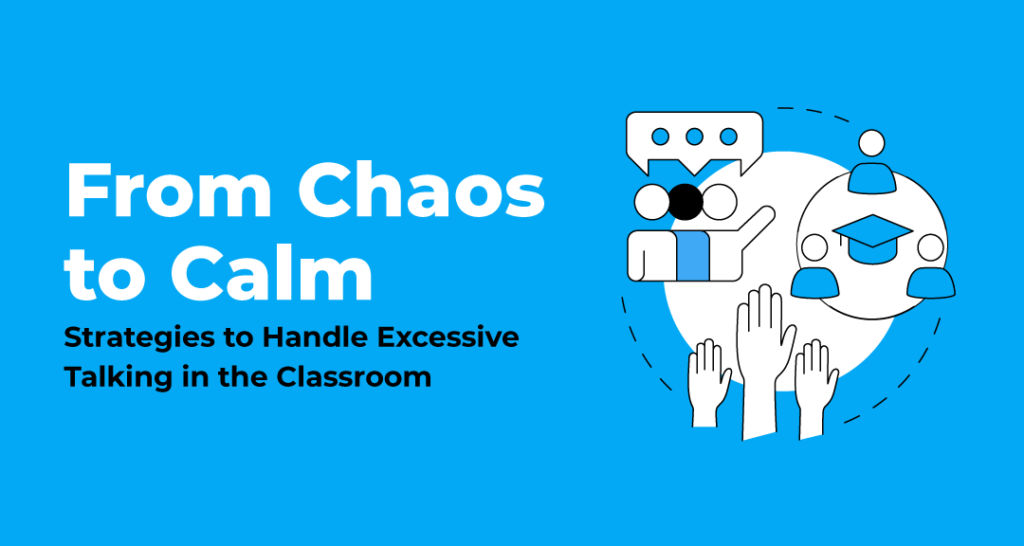From Chaos to Calm: Strategies to Handle Excessive Talking in the Classroom
- Teaching
- January 18, 2025
- VOLT Learning

The classroom was alive and filled with lots of noise from overly talkative students, which was not harmonious to the ears. The entire place looked like an orchestra, with each instrument blaring its disturbing note. There was laughter bubbling up in bursts, continuous conversational whispers, and students becoming oblivious to the teacher’s instructions.
Sounds familiar? Are you also bothered by the constant buzzing of voices that drown out the essence of learning in class? You’re not alone. Excessive talking and lack of concentration can bring chaos in the classroom and derail the learning quotient instantly while leaving you frazzled.
But what if we could turn the chaos of excessive talking into something intriguing by applying effective classroom management strategies and restoring the calm inside the classroom? Before exploring why students can’t seem to put a lid on their chatter and how you, as a teacher, can turn this challenging situation into a valuable opportunity, it is necessary to understand why your kids inside the classroom cannot stop talking.
What Are the Causes of Excessive Talking?
As a teacher, you must first accept one thing, i.e., talking is not harmful, and a quiet classroom is not always practical. When students don’t stop talking, this might be an alarming sign that you cannot strike that much-needed delicate balance between commands and spontaneity. Here are some common culprits:
- Age and developmental stage: Many younger students inside the classroom walls find it challenging to control their impulses, and they start talking without even realising that they are disturbing the learning environment.
- Social needs: Some students treat the classroom as their safe and happy place to socialise and make new friends. Uninterrupted interactions with their familiar faces are crucial to this category of students, and they engage in excessive talking as a natural outlet.
- Boredom or lack of engagement: When kids do not find the classroom teaching interesting, they engage in side conversations to escape boredom.
The battle will be won only when you encourage controlled chaos in the classroom. This happens when you address excessive talking with correct classroom management approaches and find a balance between order and spontaneity so that kids can learn and have fun at the same time.
What is Classroom Management?
Classroom management is a set of interactive practices teachers apply to minimise the chaos of excessive talking and create a productive learning environment.
These practices revolve around setting up rules and engaging kids in interactive activities involving meaningful conversations while ensuring that learning is not compromised. Effective classroom management approaches always promote student engagement, minimise disruptive behaviours, support academic development, and encourage emotional growth.
Effective classroom management strategies are categorised into several types, each with unique characteristics and approaches.
- Authoritative management is best known for balancing structure and support well. As a teacher, you can do it by consistently setting clear expectations and ensuring all your lessons and classroom activities are aligned with students’ needs. Also, make sure you encourage independence in the classroom.
- Authoritarian management, as the name suggests, strongly focuses on strict discipline and compliance. This approach gives students very little room due to a highly structured environment.
- Permissive management is a relaxed style that involves minimal rules and sufficient guidance. It focuses on providing children with greater freedom in a reduced discipline so that students can develop a sense of creativity.
- Democratic management, also known as shared leadership, is an effective classroom management strategy emphasising better collaboration and shared decision-making. Giving kids a voice in setting rules helps them develop a stronger sense of community and responsibility.
Effective classroom management strategies to handle excessive talking
Teachers dealing with chatty children must apply a combination of structure, creativity, and empathy. Some of the effective strategies that teachers may use inside the classroom to deal with excessive talking include:
1. Set Clear Expectations
Teachers should establish clear, concise, and positively worded rules to control the talking behaviour of students. For instance, they can say, “Please raise your hand to speak,” instead of saying, “Don’t talk without permission.”
When the rules are reinforced clearly and politely, students are more interested in the classroom. Teachers can also use visual reminders, such as posters or anchor charts, to communicate their expectations to the students.
2. Use Seating Arrangements Strategically
Nothing can beat the value of a well-thought-out seating arrangement. Strategically arranged seats play a more significant role in reducing distractions and excessive talking among the kids. To make the classroom more productive, teachers can avoid seating overly talkative students next to each other and plan the seating arrangement to balance the environment by pairing the most talkative ones with reserved students.
3. Incorporate Breaks and Movement
Remember that students have a short attention span and often get bored quickly. So, providing short (intentional) breaks is advisable, allowing students to engage in other activities and channel their excess energy. When this energy is left unattended, they may engage in excessive talking. Teachers can engage kids in fun activities like stretching, quick games, or mindful yoga sessions during the short break.
4. Leverage Positive Reinforcement
It is always a good strategy to encourage and reward the kids’ desirable behaviour with positive responses whenever they listen or participate respectfully. Teachers must practice using praise-centric reactions like “I appreciate how Sarah raised her hand to ask a question” or “Thank you, group no. 4, for staying focused on the task.” A supportive and positive environment effectively motivates students.
By combining these strategies and tailoring them to fit the specific needs of your students, you can create a more focused, respectful, and engaging classroom environment.
Engaging in Classroom Activities to Turn Talkative Energy Into a Strength
Here is a list of some engaging classroom management activities by age group. Teachers can use the below activities to channel their talkative energy into fun and educational experiences:
Pre-Primary (Preschool and Kindergarten)
As we all know, the pre-primary stage is the early foundation step where young kids develop essential communication, social skills, and self-expression. Therefore, teachers have to include classroom activities that are interactive, playful, and very simple.
1. Show and Tell
- How it works: Ask each child to bring their favourite item from home and engage them in a game where they describe the item in front of everyone.
- Purpose: Encourages verbal expression, listening skills, and confidence.
2. Circle Time Discussions
- How it works: Gather students in a circle and discuss simple topics like favourite animals, foods, or colours. Let each child have a turn to speak.
- Purpose: Teaches turn-taking, active listening, and sharing thoughts.
3. Storytelling with Props
- How it works: Engage kids in a fun session where a story is told using puppets, stuffed animals, or interactive flash cards. Teachers can always invite children to a storytelling activity and encourage them to tell unique stories.
- Purpose: This is how kids will be more exposed to cooperative play and vocabulary development and enhance their creativity.
4. Partner Chat Time
- How it works: Teachers can pair children in groups of two and assign them a simple topic to discuss, such as “What do you like to do outside?” Keep rotating the partners to encourage healthy interaction.
- Purpose: Kids can develop conversational skills and social interaction with this activity.
5. Action Songs and Rhymes
- How it works: Sing songs with actions, like “If You’re Happy and You Know It” or “The Wheels on the Bus.”
- Purpose: Channels talkative energy into music and movement while building language skills.
6. Role-Play Scenarios
- How it works: Set up pretend play areas (e.g., a kitchen, doctor’s office, or grocery store). Encourage children to act out roles and talk to each other.
- Purpose: Encourage imagination, social skills, and verbal communication.
Primary (Grades 1–5)
Children can accept advanced social and communication skills at this stage. Teachers can boost their skills by engaging them in fun activities and energising their collaborative skills, creative thinking, and structured dialogue.
1. Think-Pair-Share
- How it works: Questions always fuel curiosity. Teachers can turn a classroom into a productive playground by engaging the children through questions. Ask them to pair up in a group of two and let them discuss the question with their respective partners. End this activity by asking each group to share the answers with everyone.
- Purpose: This activity helps develop critical thinking and communication skills among students.
2. Classroom Debates
- How it works: Teachers can create controlled chaos in the classroom by organising small debates. Remember to keep the debate topics as simple and relatable as possible, like “Cats vs. Dogs.”
- Purpose: When kids are engaged in debates, they learn respectful argumentation and develop better critical thinking and active listening.
Middle School (Grades 6–8)
In middle school, students are physically, mentally, socially, and academically developed, which means they are ready to acquire logical reasoning and interpersonal skills. This will make them more competent and allow them to express their opinions confidently in different situations.
1. Socratic Seminars
- How it works: Teachers can organise a fun session in which children are engaged in a fruitful discussion around open-ended questions related to any particular topic.
- Purpose: When students are exposed to open discussions, they develop critical thinking, practice respectful dialogue, and improve their listening skills.
2. Mock Interviews
- How it works: Mock interviews are the most interactive and effective way to improve students’ speaking skills. Teachers can ask students to pair up in groups and let them role-play as interviewers and interviewees on a given topic.
- Purpose: It will help students speak confidently and creatively while constructing thoughts.
Conclusion
Excessive talking in class frustrates, but chaos becomes calm when the right approaches are adopted. When causes are understood and expectations are clarified, all talkative energies are channelled into appropriate productive activities.



